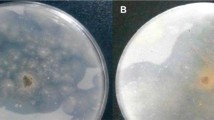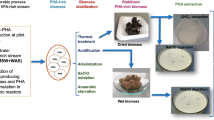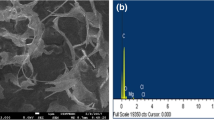Abstract
Food industry wastewater served as a carbon source for the synthesis of poly-β-hydroxybutyrate (PHB) by Azotobacter chroococcum. The content of polymer in bacterial cells grown on the raw materials reached 75%. PHB films were degraded under aerobic, microaerobic, and anaerobic conditions in the presence and absence of nitrate by microbial populations of soil, sludges from anaerobic and nitrifying/denitrifying reactors, and sediment from a sludge deposit site. Changes in molecular mass, crystallinity, and mechanical properties of PHB were studied. Anaerobic degradation was accompanied by acetate formation, which was the main intermediate utilized by denitrifying bacteria or methanogenic archaea. On a decrease in temperature from 20 to 5° C in the presence of nitrate, the rate of PHB degradation was 7.3 times lower. Under anaerobic conditions and in the absence of nitrate, no PHB degradation was observed, even at 11°C. The enrichment cultures of denitrifying bacteria obtained from soil and anaerobic sludge degraded PHB films for a short time (3–7 d). The dominant species in the enrichment culture from soil were Pseudomonas fluorescens and Pseudomonas stutzeri. The rate of PHB degradation by the enrichment cultures depended on the polymer molecular weight, which reduced with time during biodegradation.
Similar content being viewed by others
References
Braunegg, G., Lefebre, G., and Genser, K. (1998), J. Biotechnol. 65, 127–161.
Budwill, K., Fedorak, P. M., and Page, W. J. (1996), J. Environ. Polymer Degrad. 4(2), 91–102.
Bonartseva, G. A., Myshkina, V. L., and Zagreba, E. D. (1994), Microbiology 63, 45–48.
Bonartseva, G. A., Myshkina, V. L., and Zagreba, E. D. (1995), Microbiology 64, 30–33.
Page, W. J. (1992), FEMS Microbiol. Rev. 103, 149–158.
Kim, B. S. and Chang, H. N. (1998), Biotechnol. Lett. 20, 109–112.
Bonartseva, G. A., Myshkina, V. L., Zagreba, E. D., and Nikolaeva, D. A. (2001), Patent RU 2001 1128134.
Mokeeva, B. L., Chekunova, L. N., Myshkina, V. L., Nicolaeva, D. A., Gerasin, B. A., and Bonartseva, G. A. (2002), Appl. Biochem. Microbiol., in press.
Maergaert, J., Anderson, C., Wouters, A., Swings, J., and Kersters, K. (1992), FEMS Microbiol. Rev. 103, 317–322.
Savenkova, L., Gercberga, Z., Nikolaeva, V., Dzene, A., Bibers, J., and Kalnin, M. (2000), Process Biochem. 35, 573–579.
Brandle, H., Bachofen, R., Mayer, J., and Wintermantel, E. (1995), Can. J. Microbiol. 41, 143–153.
Scandola, M. (1995), Can. J. Microbiol. 41, 310–315.
Koyama, N. and Doi, Y. (1995), Can. J. Microbiol. 41, 316–322.
Biedermann, J., Owen, A. J., Schloe, K. T., Gassner, P., and Susmuth, R. (1997), Can. J. Microbiol. 43, 561–569.
Kalyuzhnyi, S., Sklyar, V., Archipchenko, I., Barboulina, I., Orlova, O., Epov, A., Nekrasova, V., Nozhevnikova, A., Kovalev, A., and Derikx, P. (2000), in Proceedings of International Conference on Microbial Ecotechnology in Processing of Organic and Agricultural Wasters, Arkhipchenko, J. and Kalyuzhnyi, S., eds., Express, St. Petersburg, Russia, pp. 40–48.
Nozhevnikova, A. N., Nekrasova, V. K., Kevbrina, M. V., and Kotsyurbenko, O. R. (2001), Water Sci. Technol. 44(4), 89–95.
Quevedo, M., Guynot, E., and Muxi, L. (1996), Biotechnol. Lett. 18(12), 1363–1368.
Pfenning, N. and Lippert, K. D. (1966), Arch. Microbiol. 55, 245, 246.
Wolin, E. A., Wolin, M. J., and Wolfe, R. S. (1963), J. Biol. Chem. 238, 2882–2886.
Pfenning, N. (1965), Zbl. Bakt. I. Abt. Orig. Suppl. 1, 179–189.
Akita, S., Einaga, Y., Miyaki, Y., and Fujita, H. (1975), Macromolecules 9, 774–780.
Rebrov, A. V., Bonartseva, G. A., Dubinscii, V. A., Necrasov, Y. P., and Antipov, E. M. (2002), Polymer Sci. A 44(2), 1–5.
Buchanan, R. E. and Gibbons, N. E. (1974), in Bergey's Manual of Determinative Bacteriology, 8th ed., Holt, J. G., ed., Williams & Wilkins, Baltimore, pp. 122–127.
Spyros, A., Kimmich, R., Briese, D. H., and Jendrossek, D. (1997), Macromolecules 30, 8218–8225.
Doi, Y., Kanesawa, Y., and Kunioka, M. (1990), Macromolecules 23, 26–31.
Hocking, P. J., Marchessault, R. H., Timmins, M. R., Lenz, R. W., and Fuller, R. C. (1996), Macromolecules 29, 2472–2478.
Author information
Authors and Affiliations
Corresponding author
Rights and permissions
About this article
Cite this article
Bonartseva, G.A., Myshkina, V.L., Nikolaeva, D.A. et al. Aerobic and anaerobic microbial degradation of poly-β-hydroxybutyrate produced by Azotobacter chroococcum . Appl Biochem Biotechnol 109, 285–301 (2003). https://doi.org/10.1385/ABAB:109:1-3:285
Issue Date:
DOI: https://doi.org/10.1385/ABAB:109:1-3:285




